Developing a Cloud-Reduced MODIS Surface Reflectance Product for Snow Cover Mapping in Mountainous Regions
Abstract
:1. Introduction
2. Study Area and Data Sets
2.1. Study Area
2.2. Remotely Sensed Data
3. Methodology
3.1. Cloud Removal Methods
3.1.1. K-Nearest Neighbors
3.1.2. Dynamic Time Composite
3.1.3. Combination of Methods
3.2. Snow Mapping
- NDSI = > 0.4
- Band 2 reflectance > 11%
- Band 4 reflectance > 10%
3.3. Validation Methodology
4 Results
4.1. Cloud Removal Performance
4.2. Undercloud Surface Reflectance Estimation
4.3. Snow Mapping
5. Discussion and Conclusions
Author Contributions
Conflicts of Interest
References
- Franz, K.J.; Karsten, L.R. Calibration of a distributed snow model using MODIS snow covered area data. J. Hydrol. 2013, 494, 160–175. [Google Scholar] [CrossRef]
- Parajka, J.; Blöschl, G. The value of MODIS snow cover data in validating and calibrating conceptual hydrologic models. J. Hydrol. 2008, 358, 240–258. [Google Scholar] [CrossRef]
- Berezowski, T.; Chormański, J.; Batelaan, O. Skill of remote sensing snow products for distributed runoff prediction. J. Hydrol. 2015, 524, 718–732. [Google Scholar] [CrossRef]
- Mcguire, M.; Wood, A.W.; Hamlet, A.F.; Lettenmaier, D.P. Use of satellite data for streamflow and reservoir storage forecasts in the Snake River Basin. J. Water Resour. Plan. Manag. 2006, 132, 97–110. [Google Scholar] [CrossRef]
- Wang, R.; Yao, Z.; Liu, Z.; Wu, S.; Jiang, L.; Wang, L. Snow cover variability and snowmelt in a high-altitude ungauged catchment. Hydrol. Process. 2015, 29, 3665–3676. [Google Scholar] [CrossRef]
- Tang, Z.; Wang, J.; Li, H.; Yan, L. Spatiotemporal changes of snow cover over the Tibetan plateau based on cloud-removed moderate resolution imaging spectroradiometer fractional snow cover product from 2001 to 2011. J. Appl. Remote Sens. 2013, 7, 73582. [Google Scholar] [CrossRef]
- Tahir, A.A.; Chevallier, P.; Arnaud, Y.; Ashraf, M.; Bhatti, M.T. Snow cover trend and hydrological characteristics of the Astore River basin (Western Himalayas) and its comparison to the Hunza basin (Karakoram region). Sci. Total Environ. 2014, 505, 748–761. [Google Scholar] [CrossRef] [PubMed]
- She, J.; Zhang, Y.; Li, X.; Feng, X. Spatial and temporal characteristics of snow cover in the Tizinafu watershed of the Western Kunlun Mountains. Remote Sens. 2015, 7, 3426–3445. [Google Scholar] [CrossRef]
- Paudel, K.P.; Andersen, P. Monitoring snow cover variability in an agropastoral area in the Trans Himalayan region of Nepal using MODIS data with improved cloud removal methodology. Remote Sens. Environ. 2011, 115, 1234–1246. [Google Scholar] [CrossRef]
- Parajka, J.; Blöschl, G. Validation of MODIS snow cover images over Austria. Hydrol. Earth Syst. Sci. 2006, 10, 679–689. [Google Scholar] [CrossRef]
- Andreadis, K.M.; Lettenmaier, D.P. Assimilating remotely sensed snow observations into a macroscale hydrology model. Adv. Water Resour. 2006, 29, 872–886. [Google Scholar] [CrossRef]
- Tekeli, A.E.; Akyürek, Z.; Arda Şorman, A.; Şensoy, A.; Ünal Şorman, A. Using MODIS snow cover maps in modeling snowmelt runoff process in the eastern part of Turkey. Remote Sens. Environ. 2005, 97, 216–230. [Google Scholar] [CrossRef]
- Wang, X.; Xie, H.; Liang, T.; Huang, X. Comparison and validation of MODIS standard and new combination of Terra and Aqua snow cover products in northern Xinjiang, China. Hydrol. Process. 2009, 23, 419–429. [Google Scholar] [CrossRef]
- Da Ronco, P.; De Michele, C. Cloud obstruction and snow cover in Alpine areas from MODIS products. Hydrol. Earth Syst. Sci. 2014, 18, 4579–4600. [Google Scholar] [CrossRef]
- Gafurov, A.; Bardossy, A. Cloud removal methodology from MODIS snow cover product. Hydrol. Earth Syst. Sci. 2009, 13, 1361–1373. [Google Scholar] [CrossRef]
- Hall, D.K.; Riggs, G.A.; Foster, J.L.; Kumar, S.V. Development and evaluation of a cloud-gap-filled MODIS daily snow-cover product. Remote Sens. Environ. 2010, 114, 496–503. [Google Scholar] [CrossRef]
- Wang, X.; Zheng, H.; Chen, Y.; Liu, H.; Liu, L.; Huang, H.; Liu, K. Mapping snow cover variations using a MODIS daily cloud-free snow cover product in northeast China. J. Appl. Remote Sens. 2014, 8, 084681. [Google Scholar] [CrossRef]
- Parajka, J.; Pepe, M.; Rampini, A.; Rossi, S.; Blöschl, G. A regional snow-line method for estimating snow cover from MODIS during cloud cover. J. Hydrol. 2010, 381, 203–212. [Google Scholar] [CrossRef]
- Dong, C.; Menzel, L. Producing cloud-free MODIS snow cover products with conditional probability interpolation and meteorological data. Remote Sens. Environ. 2016, 186, 439–451. [Google Scholar] [CrossRef]
- Parajka, J.; Blöschl, G. Spatio-temporal combination of MODIS images—Potential for snow cover mapping. Water Resour. Res. 2008, 44, W03406. [Google Scholar] [CrossRef]
- Dariane, A.B.; Khoramian, A.; Santi, E. Investigating Spatiotemporal Snow Cover Variability via Cloud-free MODIS Snow Cover Product in Central Alborz region. Remote Sens. Environ. 2017, in press. [Google Scholar]
- Islamic Republic of Iran Meteorological Organization (IRIMO). Annual Report of National Crisis Management and Climatic Hazards; IRIMO: Tehran, Iran, 2014. [Google Scholar]
- Mossadegh, A. Aperçu général sur les hêtraies montagnardes des forêts de la Caspienne en Iran. Rev. For. Fr. 1968, 20–27. Available online: http://documents.irevues.inist.fr/bitstream/handle/2042/24925/RFF_1968_1_20.pdf?sequence=1&isAllowed=y (accessed on 17 April 2017). [CrossRef]
- Vermote, E.F.; Kotchenova, S.Y.; Ray, J.P. MODIS Land Surface Reflectance Science Computing Facility. In MODIS Surface Reflectance User’s Guide; version 1.4; National Aeronautics and Space Administration (NASA): Washington, DC, USA, 2011. [Google Scholar]
- Reverb, The Next Generation Metadata and Service Discovery Tool. Available online: https://reverb.echo.nasa.gov/reverb (accessed on 15 September 2016).
- Hall, D.K.; Riggs, G.A.; Salomonson, V.V.; DiGirolamo, N.E.; Bayr, K.J. MODIS snow-cover products. Remote Sens. Environ. 2002, 83, 181–194. [Google Scholar] [CrossRef]
- Dong, C.; Menzel, L. Improving the accuracy of MODIS 8-day snow products with in situ temperature and precipitation data. J. Hydrol. 2016, 534, 466–477. [Google Scholar] [CrossRef]
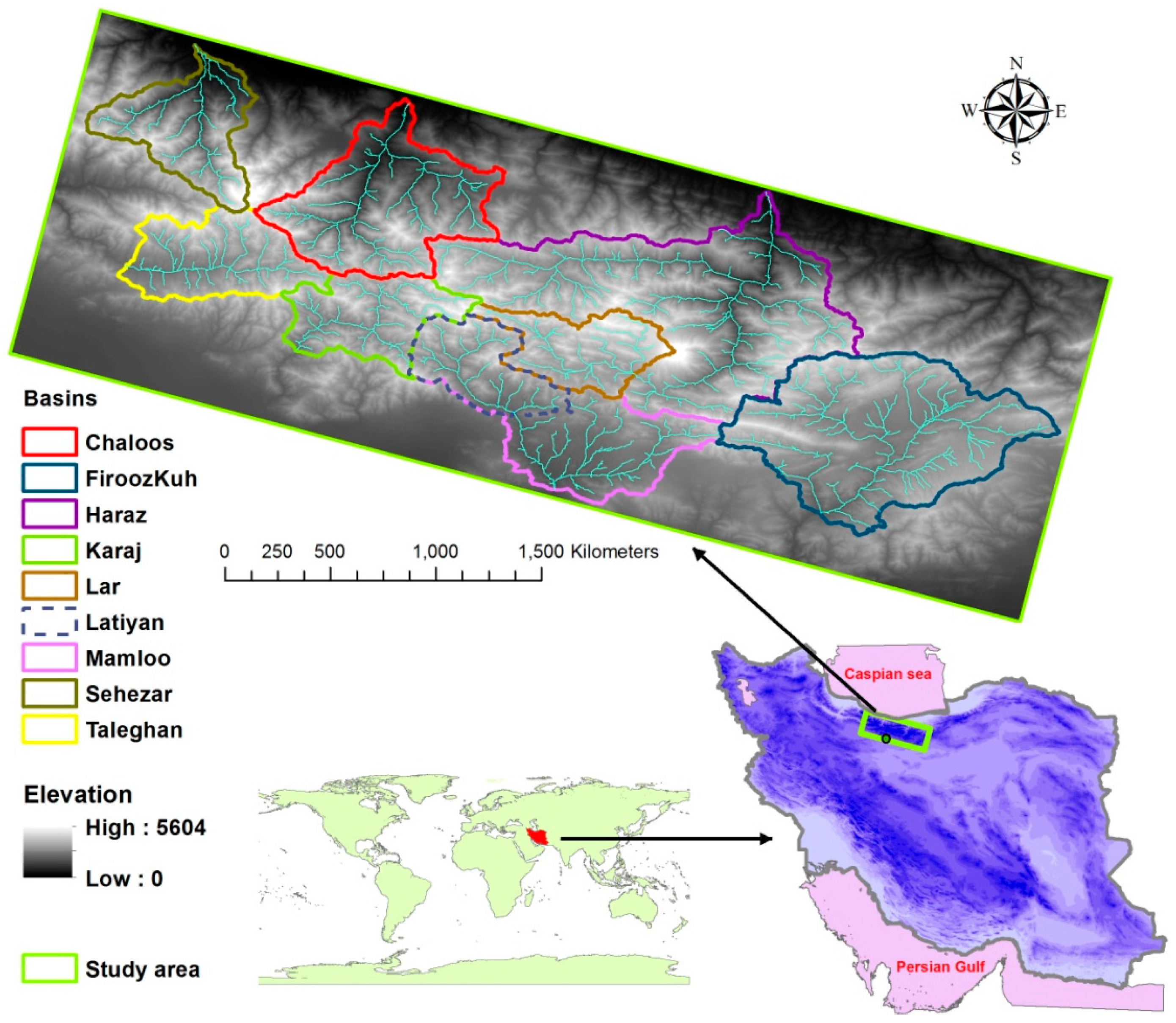
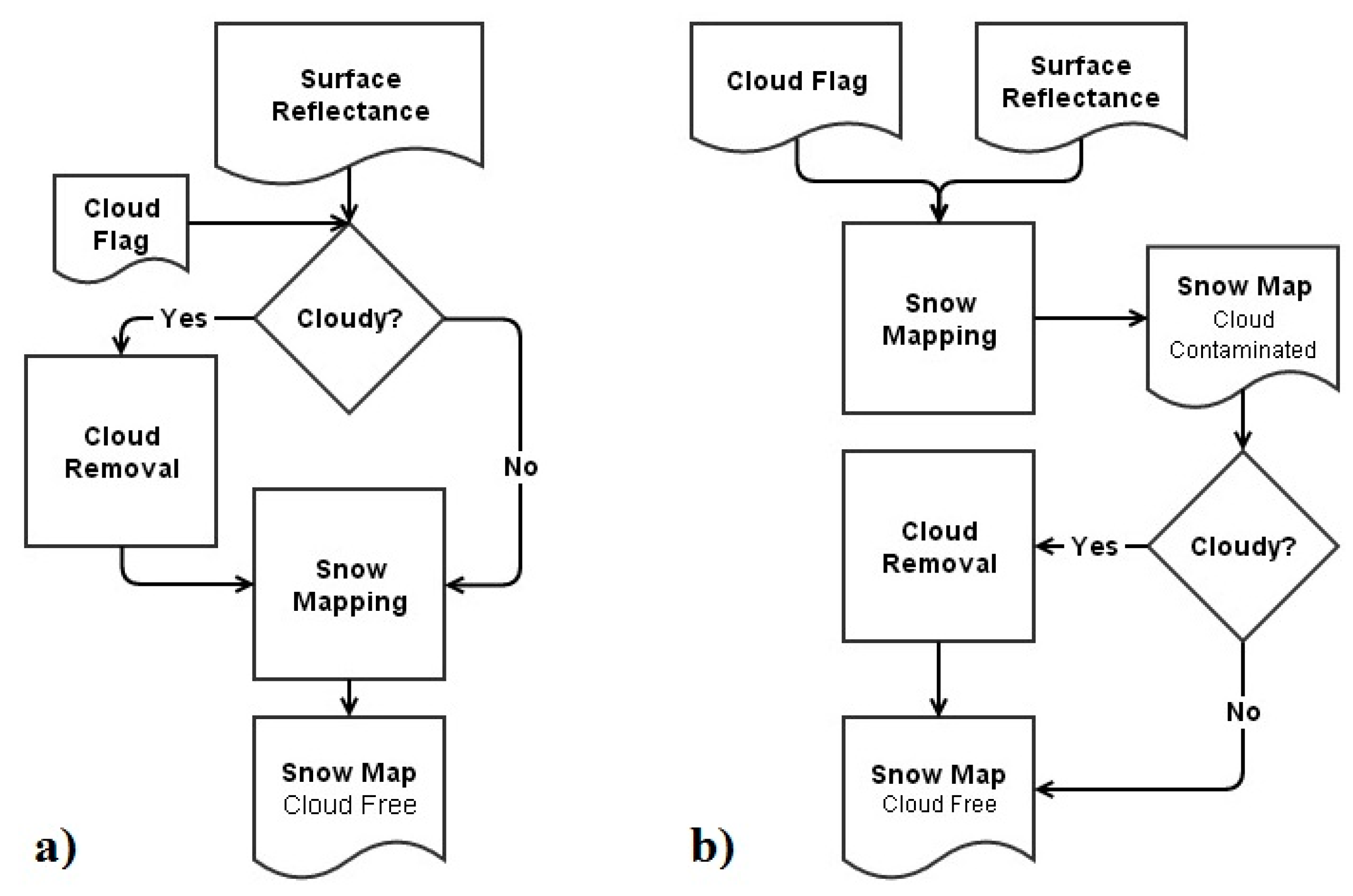
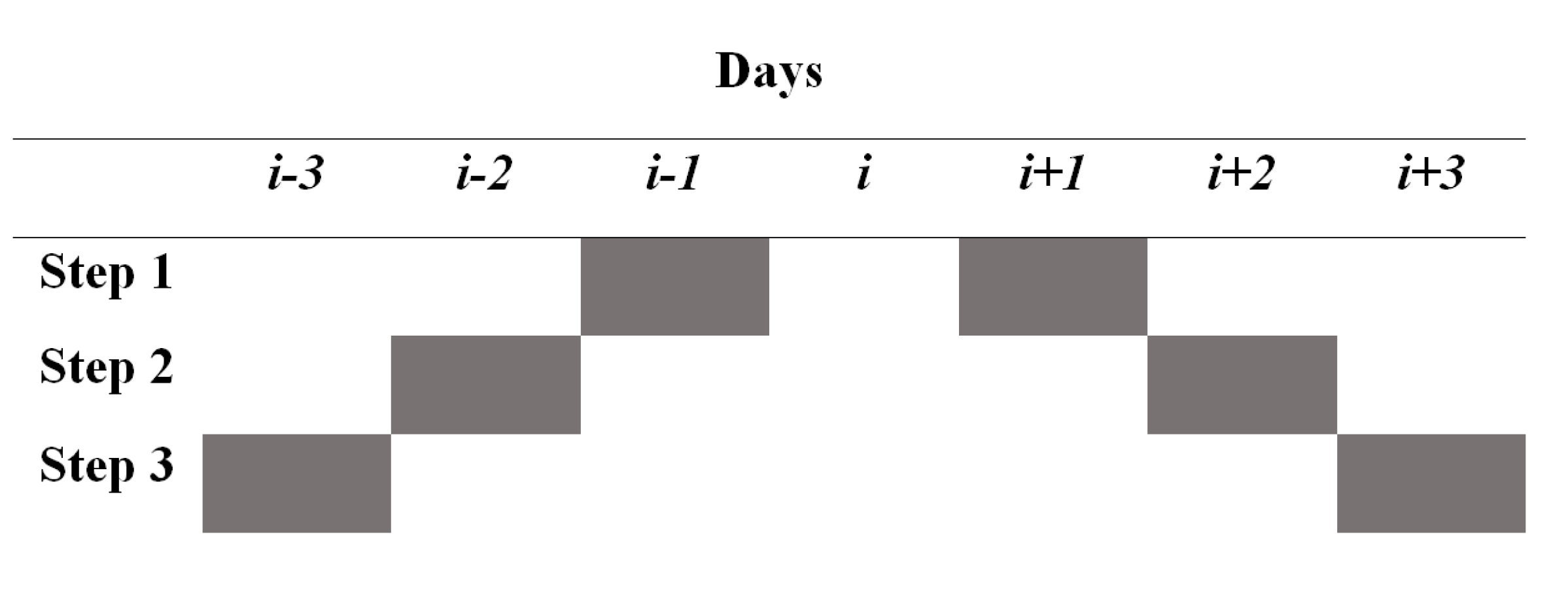
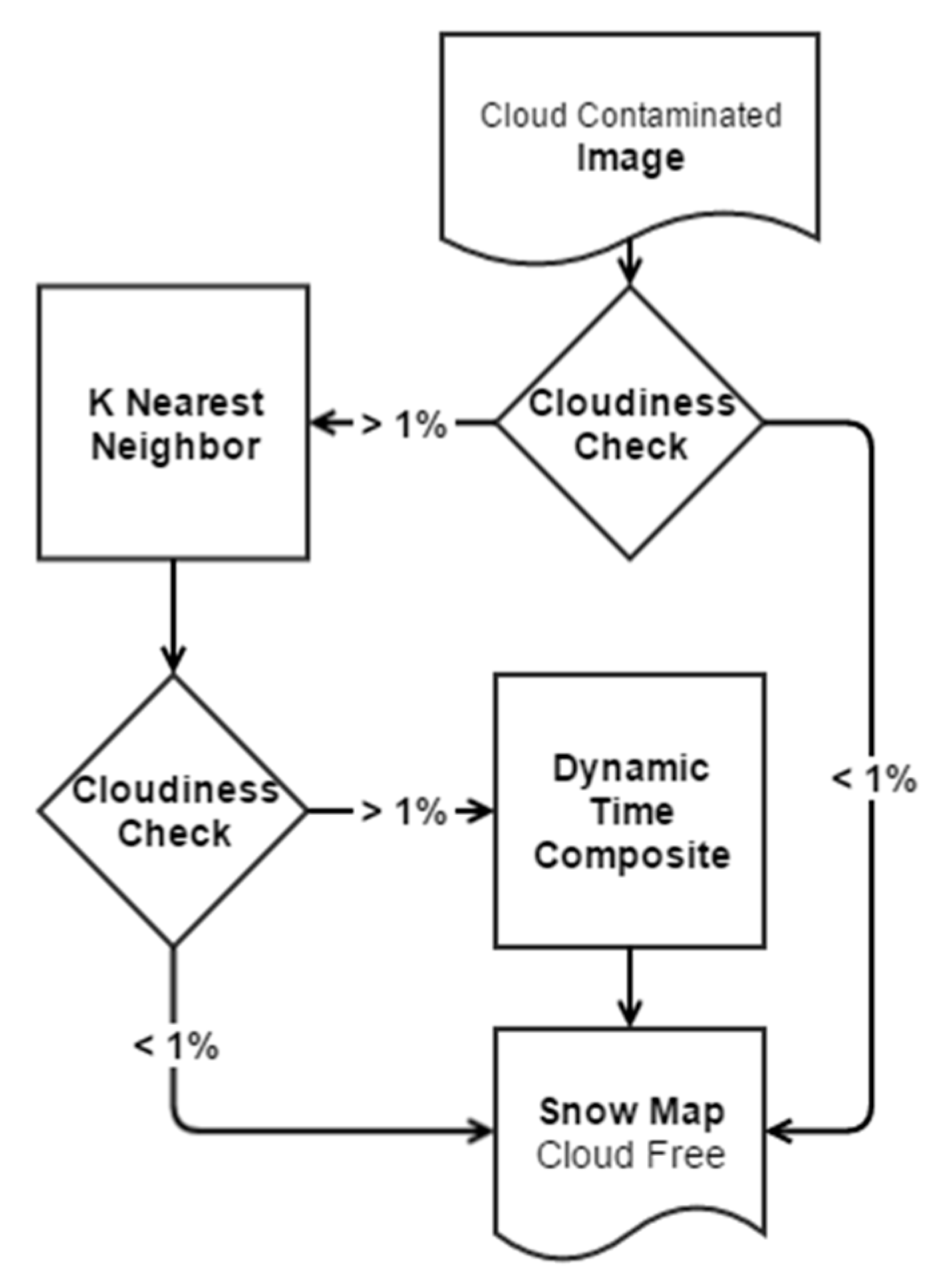
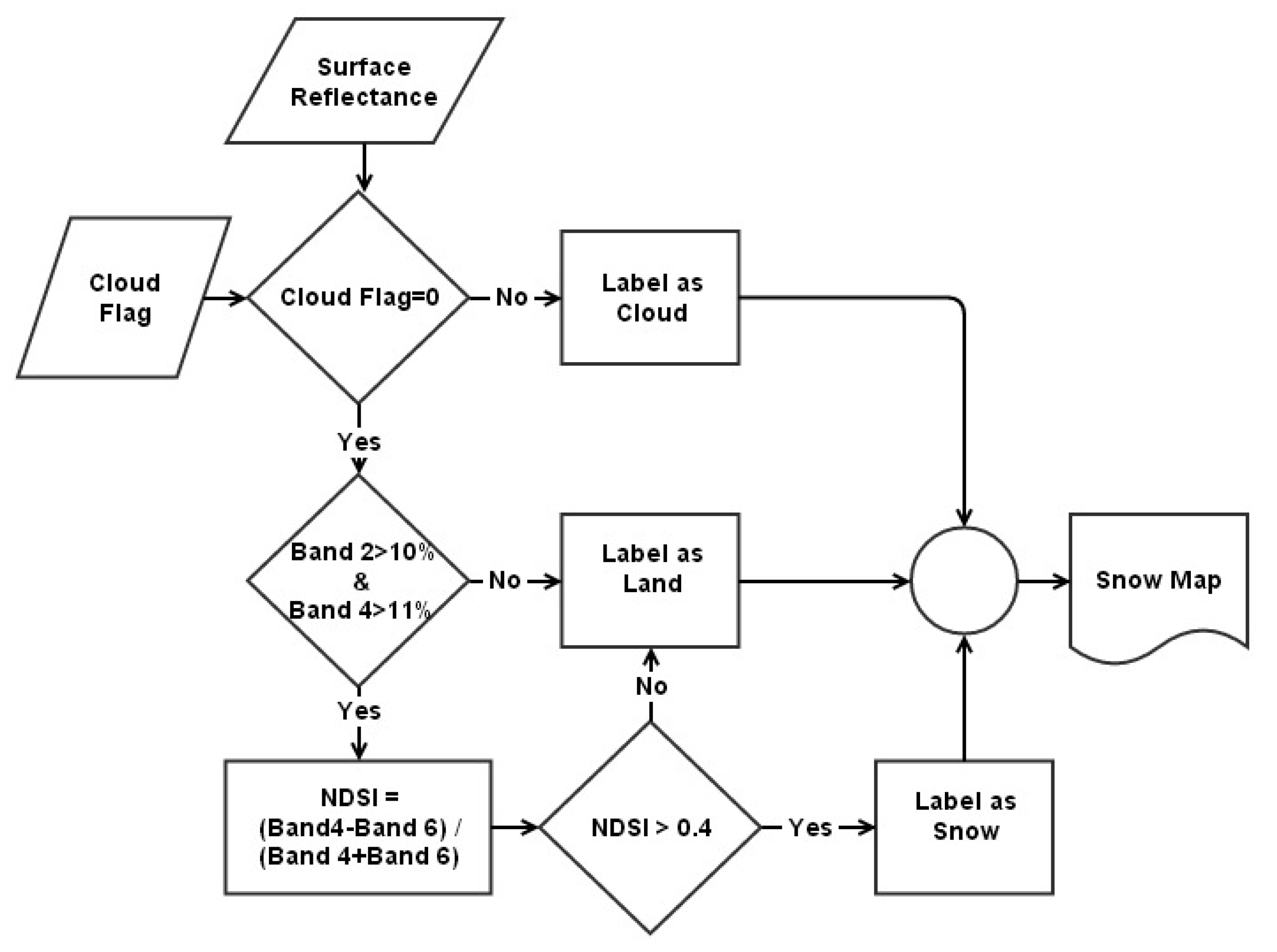
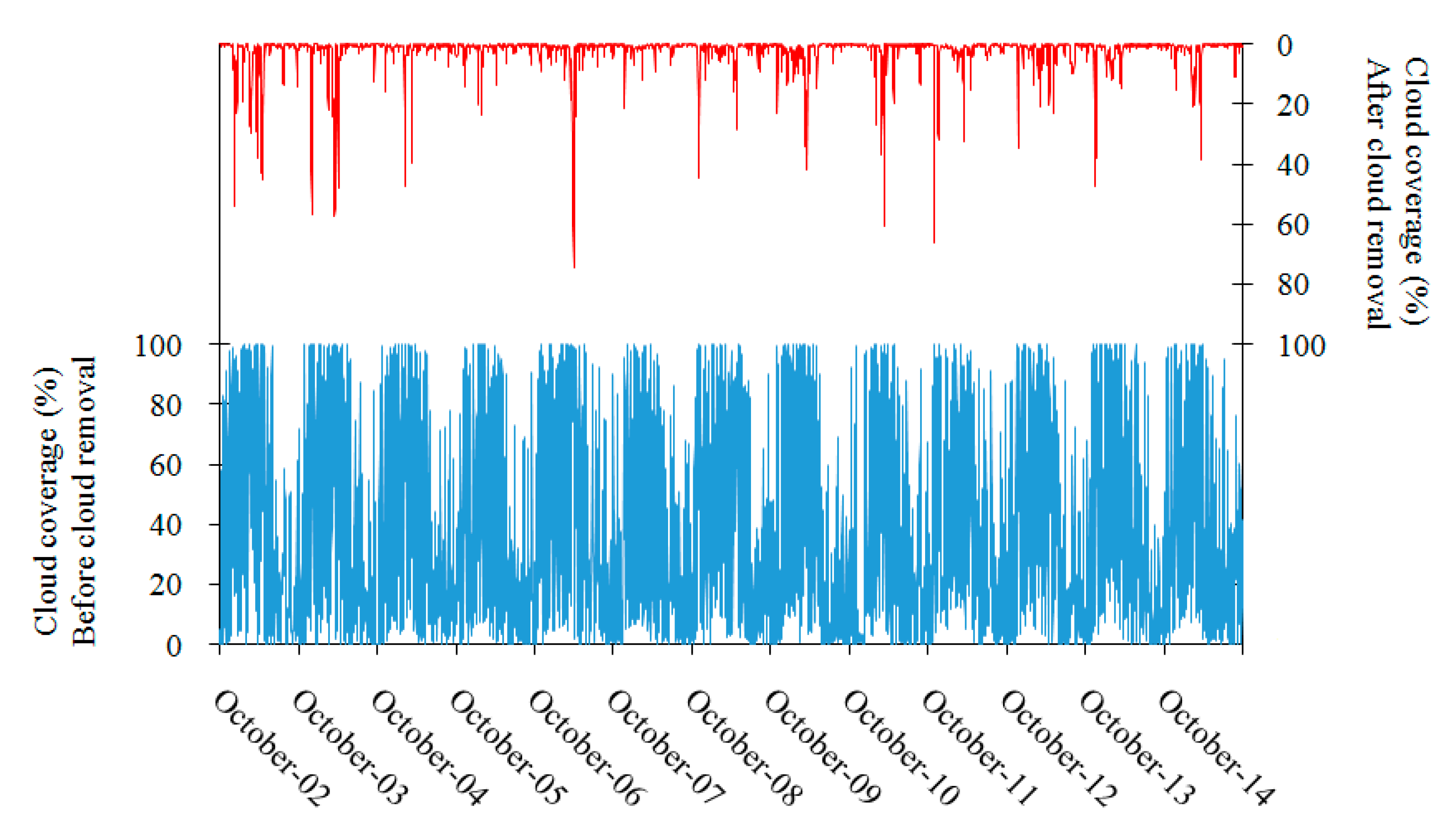
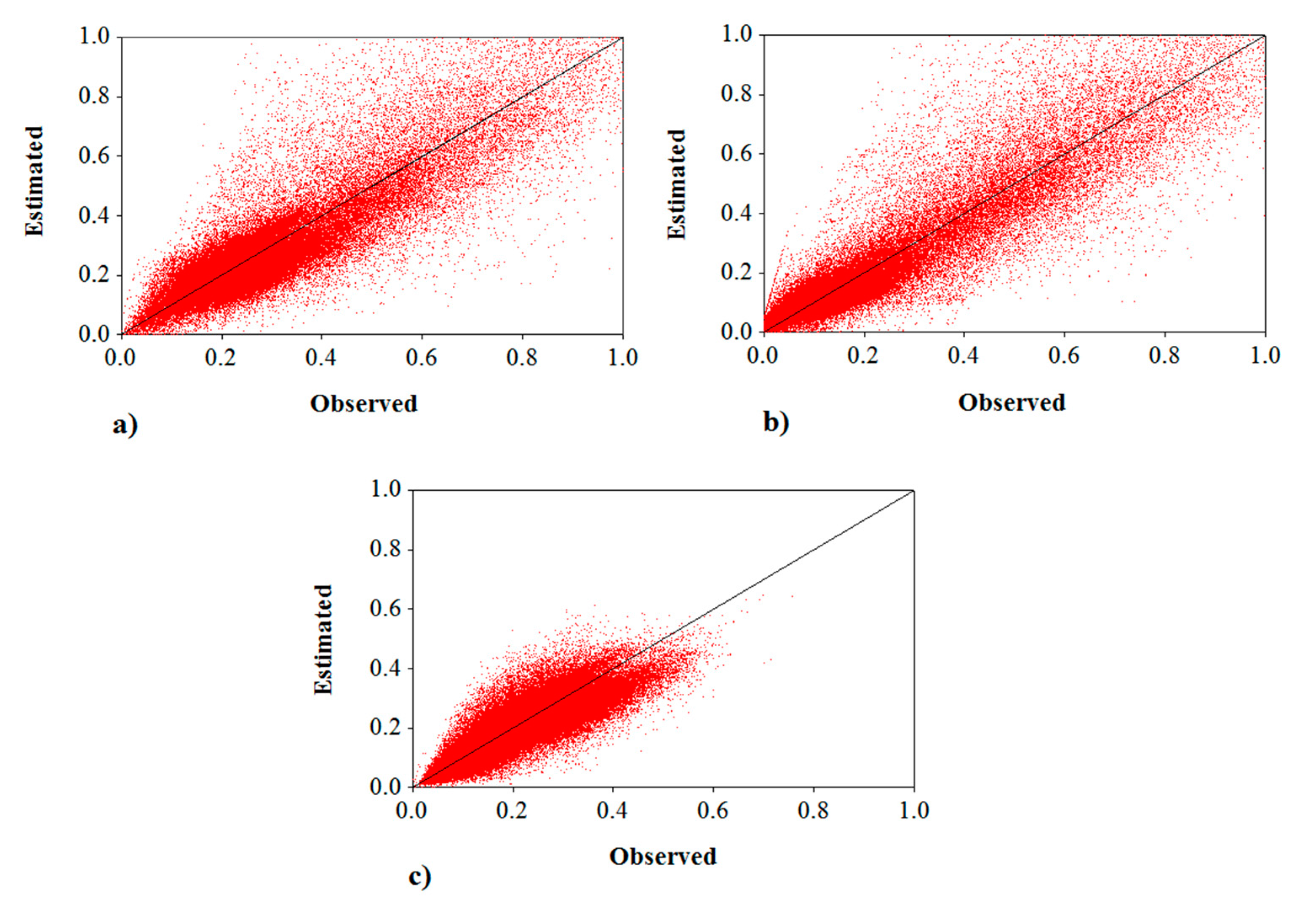

| Cloudiness | Winter | Autumn | Spring | Summer | Annual |
|---|---|---|---|---|---|
| Original amount of cloud (%) | 56.3 | 38.0 | 18.7 | 38.3 | 37.8 |
| Remained cloud (%) | 4.3 | 1.7 | 1.0 | 2.1 | 2.2 |
| Percent reduction | 92.3 | 95.6 | 94.9 | 94.6 | 94.1 |
| Validation Criteria | Band 2 | Band 4 | Band 6 |
|---|---|---|---|
| Mean Bias | 0.066 | 0.054 | 0.051 |
| RMSE | 0.09 | 0.082 | 0.063 |
| R2 | 0.75 | 0.85 | 0.61 |
| r | 0.87 | 0.92 | 0.85 |
| Original Snow Map | Cloud-Removed Snow Map | ||
|---|---|---|---|
| Snow | Land | In Overall | |
| Snow | 22,146 (85.3%) | 3830 (14.7%) | 25,976 |
| Land | 0 (0%) | 86,761 (100%) | 86,761 |
| In overall | 22,146 | 90,591 | 112,737 |
| Overall accuracy: | 97% | ||
| Original Snow Map | Cloud-Removed Snow Map | ||
|---|---|---|---|
| Snow | Land | In Overall | |
| Snow | 18,224 (70.2%) | 7752 (29.8%) | 25,976 |
| Land | 7422 (8.6%) | 79,340 (91.4%) | 86,761 |
| In overall | 22,146 | 90,591 | 112,737 |
| Overall accuracy: | 86% | ||
© 2017 by the authors. Licensee MDPI, Basel, Switzerland. This article is an open access article distributed under the terms and conditions of the Creative Commons Attribution (CC BY) license (http://creativecommons.org/licenses/by/4.0/).
Share and Cite
Khoramian, A.; Dariane, A.B. Developing a Cloud-Reduced MODIS Surface Reflectance Product for Snow Cover Mapping in Mountainous Regions. Geosciences 2017, 7, 29. https://doi.org/10.3390/geosciences7020029
Khoramian A, Dariane AB. Developing a Cloud-Reduced MODIS Surface Reflectance Product for Snow Cover Mapping in Mountainous Regions. Geosciences. 2017; 7(2):29. https://doi.org/10.3390/geosciences7020029
Chicago/Turabian StyleKhoramian, Amin, and Alireza B. Dariane. 2017. "Developing a Cloud-Reduced MODIS Surface Reflectance Product for Snow Cover Mapping in Mountainous Regions" Geosciences 7, no. 2: 29. https://doi.org/10.3390/geosciences7020029





